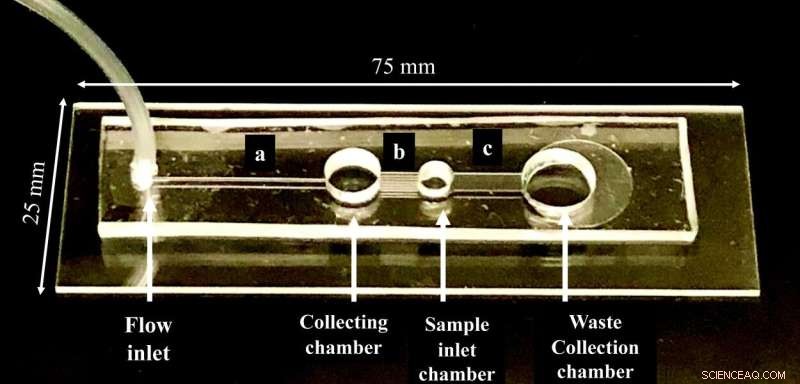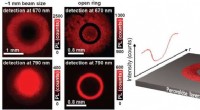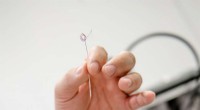Enhed dirigerer sædcellerne til at gå imod strømmen for at hjælpe med infertilitet

Den mikrofluidiske chip består af fire cylindriske kamre forbundet gennem mikrokanaler:væskeindløbskammeret, opsamlingskammeret, prøveindløbskammeret og affaldsopsamlingskammeret. Kredit:Florida Atlantic University
Det kvindelige kønsorgan kan være et fjendtligt miljø for undfangelse. Ud af omkring 100 millioner sædceller er det kun et par hundrede, der når æggelederne. Ledet af en retningsbestemt bevægelse kaldet rheotaxis svømmer sædceller mod den cervikale slimstrøm for at nå ægget til befrugtning. Denne rejse er dog endnu mere kritisk, når man overvejer infertilitet. Spermmotilitet - evnen til at svømme den rigtige vej - er nøglen.
Ved at drage fordel af denne naturlige rheotaxis adfærd af sæd, har forskere fra Florida Atlantic University's College of Engineering and Computer Science udviklet en mikrofluidisk chip til sædsortering, der er hurtig, billig, nem at betjene og effektivt isolerer sund sæd direkte fra sæd. Vigtigere er det, at den uden besvær opsamler sorterede sædceller fra opsamlingskammeret, mens den minimerer kontaminering med deforme eller døde sædceller.
Assisterede reproduktionsteknologier såsom in vitro fertilisering (IVF), intrauterin insemination og intracytoplasmatisk sædinjektion kræver alle sunde sædceller for et vellykket resultat. Nuværende centrifugeringsmetoder til sædsortering kræver flere trin, flere typer udstyr og tager omkring to timer at isolere sædceller. Disse metoder beskadiger sædceller under bearbejdning og inducerer betydelig DNA-fragmentering og oxidativt stress.
Resultaterne af undersøgelsen, offentliggjort i tidsskriftet The Analyst fra Royal Society of Chemistry, viste, at sædceller isoleret fra opsamlingskammeret i denne mikrofluidiske chip udviste signifikant højere motilitet (næsten 100 procent), et højere antal morfologisk normale celler og væsentligt lavere DNA-fragmentering, hvilket er en afgørende parameter for befrugtningsproces. Derudover giver den udviklede chip mere end nok celler, der kræves til en vellykket intracytoplasmatisk sædinjektion på grund af mængden og kvaliteten af sædceller, der er isoleret ved hjælp af chippen.
"Det er meget nemt at betjene vores chip. Når sæden er fyldt ind i prøveindløbskammeret, begynder de kompetente sædceller at bevæge sig mod væskestrømmen mod opsamlingskammeret, hvorfra de nemt kan opsamles," sagde Waseem Asghar, Ph.D. , seniorforfatter, lektor i FAU's Institut for Elektroteknik og Datalogi, og medlem af FAU Institut for Human Health and Disease Intervention (I-Health) og FAU Institute for Sensing and Embedded Network Systems Engineering (I-SENSE) . "Derudover tilbyder denne chip en et-trins, en times driftsfordel, som en operatør kan bruge med minimal træning."
The study also validates that rheotaxis selects the healthy, motile, and higher velocity sperm cells for the fertilization process.
"The assembly of the microfluidic chip is low-cost, and the reagents used in the chip to separate sperm cells are only a few milliliters, therefore, the commercial cost of the chip would be less than $5," said Asghar. "Moreover, this technology will considerably reduce the economic burden of fertility implementations and both the chip and the sperm cells isolated from it offer great clinical significance and applicability."
The microfluidic chip consists of four cylindrical chambers that are connected through the microchannels. The four chambers are the fluid inlet chamber, collecting chamber, sample inlet chamber, and waste collection chamber. The channel between the collecting chamber and sample inlet contains microgrooves to guide the sperm cells in addition to the fluid flow for the rheotaxis movement of the sperm cells towards the collecting chamber.
The shear stress inside the device is generated by fluid flow using a syringe pump. A raw semen sample is then added to the sample inlet chamber from where functional sperm cells will swim towards the collecting chamber, effectively separating themselves from dead and immotile sperm.
"Conventional centrifugation often compromises the integrity of sperm cells. This research study demonstrates that the microfluidic chip developed by professor Asghar and his colleagues eliminates this issue," said Stella Batalama, Ph.D., dean, College of Engineering and Computer Science. "This novel technology offers a platform where the sperm cells experience different shear stress in different parts of the chip, which facilitates the isolation of competent sperm cells without impacting their integrity."
In the United States, an estimated 15 percent of couples have trouble conceiving. Globally, approximately 48.5 million couples experience infertility. According to the U.S. Centers for Disease Control and Prevention, 12 percent of women of childbearing age have used an infertility service. All treatment costs for infertility can range from $5,000 to $73,000. The average patient goes through two IVF cycles, bringing the total cost of this procedure, including medications, between $40,000 and $60,000. An estimated 85 percent of IVF costs are often paid out-of- pocket. + Udforsk yderligere
Survival of the fittest sperm:How new technology may help infertile couples
 Varme artikler
Varme artikler
-
 Anvendelse af syrer og baserSyrer og baser sidder i modsatte ender af pH eller potentiale for brint, skala: Syrer sidder tættere på nul, og baser sidder tættere på 14. Hvert kemikalie har et andet pH-niveau og sammen med det, en
Anvendelse af syrer og baserSyrer og baser sidder i modsatte ender af pH eller potentiale for brint, skala: Syrer sidder tættere på nul, og baser sidder tættere på 14. Hvert kemikalie har et andet pH-niveau og sammen med det, en -
 Foto-induceret ionforskydning i blandede halogenidperovskitter til et batteri, der kan oplades direk…PL-emissionskortlægning af MA0.17FA0.83Pb(I0.5Br0.5)3 ved detektionsbølgelængden på 670 nm og 790 nm efter lokal belysning i 1 time med en strålestørrelse på ~ 1 mm og tæthed på 1 sol på den bare film
Foto-induceret ionforskydning i blandede halogenidperovskitter til et batteri, der kan oplades direk…PL-emissionskortlægning af MA0.17FA0.83Pb(I0.5Br0.5)3 ved detektionsbølgelængden på 670 nm og 790 nm efter lokal belysning i 1 time med en strålestørrelse på ~ 1 mm og tæthed på 1 sol på den bare film -
 Forbedret forståelse af industrielle elektrodeprocesserElektroden, der bruges til målingerne, er kun en hundrededel i tykkelsen af et menneskehår. Kredit:RUB, Marquard I den industrielle produktion af klor, specielle elektroder er for nylig blevet i
Forbedret forståelse af industrielle elektrodeprocesserElektroden, der bruges til målingerne, er kun en hundrededel i tykkelsen af et menneskehår. Kredit:RUB, Marquard I den industrielle produktion af klor, specielle elektroder er for nylig blevet i -
 Plastik fra træ? Røntgenanalyse viser vej til ligninbaserede komponenter fremstillet efter målLignin er et lovende råmateriale (til venstre) til termoplastproduktion (til højre). Kredit:KTH Stockholm, Marcus Jawerth Biopolymeren lignin er et biprodukt fra papirfremstilling og et lovende rå
Plastik fra træ? Røntgenanalyse viser vej til ligninbaserede komponenter fremstillet efter målLignin er et lovende råmateriale (til venstre) til termoplastproduktion (til højre). Kredit:KTH Stockholm, Marcus Jawerth Biopolymeren lignin er et biprodukt fra papirfremstilling og et lovende rå
- Forskere opdager strukturen af anti-aging hormon
- Edgy kig på 2-D molybdendisulfid
- Fem år efter tyfonen Haiyan, scorer stadig i skade
- Forskere finder en mulig erstatning for platin som katalysator
- Tekstil-baserede kompositter kan væve fremtiden for rumfartsteknik
- Astrofysikere finder ud af, at planetariske harmonier omkring TRAPPIST-1 redder den fra ødelæggels…


